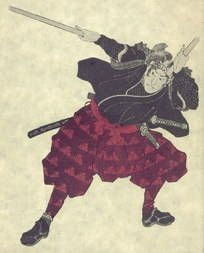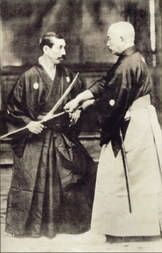Kendo History

‘The Way of The Sword’, embodies the essence of the Japanese fighting arts. Since the earliest samurai government in Japan, during the Kamakura period (1185-1233), sword fencing, together with horse riding and archery, were the main martial pursuits of the military clans. In this period Kendo developed under the strong influence of Zen Buddhism. The samurai could equate the disregard for his own life in the heat of battle, which was considered necessary for victory in individual combat to Buddhist concept of the illusory nature of the distinction between life and death.
Since that time many warriors have become enlightened through Kendo practice. Those swordsmen established schools of Kendo training which continued for centuries, and which form the basis of Kendo practice today.
The names of the schools reflect the essence of the originator’s enlightenment. Thus the Itto-Ryu (Single sword school) indicates the founder’s illumination that all possible cuts with the sword emanate from and are contained in one original essential cut. The Muto (swordless school) expresses the comprehension of the originator Yamaoka Tesshu, that “There is no sword outside the mind”. The ‘Munen Muso Ryu’ (No Intent, No preconception) similarly expresses the understanding that the essence of Kendo transcends the reflective thought process.


The formal Kendo exercises set down sometimes several centuries ago are studied today using wooden swords in set forms, or ‘kata’. Uninhibited
sword fencing using bamboo practice swords and substantial armour both by formal exercises and free fencing. Thus today it is possible to embark on the quest for spiritual enlightenment followed by the samurai of old. Concepts such as ‘Mushin’, or ’empty mind’ as professed by exponents of Zen are an essential attainment for high level Kendo. Fudo-Shin, or ‘Unmoving Mind’, a conceptual attribute of the deity Fudo Myo-O, one of the five ‘Kings of Light’ of Shingon Buddhism, implies that the fencer cannot be led astray by delusions of anger, doubt, fear, or surprise arising from his opponent’s actions.
Many of these concepts are relevant to other arts, like Judo, calligraphy, and the Tea Ceremony, but they are more readily comprehended in Kendo because the formal ‘kata’ exercises which were designed to express them can be performed in free practice at all levels from beginner to master swordsman. Other advantages of Kendo are that it can be practised by both young and old irrespective of natural ability. Physical fitness may be an advantage, but it is not essential. Thus young children and beginners can practice constructively and enjoyably with skilful people of advanced age. There are many formidable Kendo exponents of advanced age, even as old as eighty or ninety years, who can beat young champions a fraction of their age.
Kendo teaches methods of breathing to produce reserves of energy although you may be thoroughly tired. ‘Ki-ai’ shouting during fencing aids the circulation, and imparts vigour to the mind and body. Since the armour is fully protective Kendo study is not painful so you can overcome fear of aggression, and learn to remain calm in face of adversity through ordinary practice. Above all Kendo is enjoyable, and you will be welcome in any club in any country in which Kendo is practised. Teaching in Kendo is mutual, and the Kendo adherent will always find someone who will help them freely and willingly, until they reach the highest level of all as enlightened swordsmen. (practitioner of Kendo)
From an article by Mr Victor Harris
